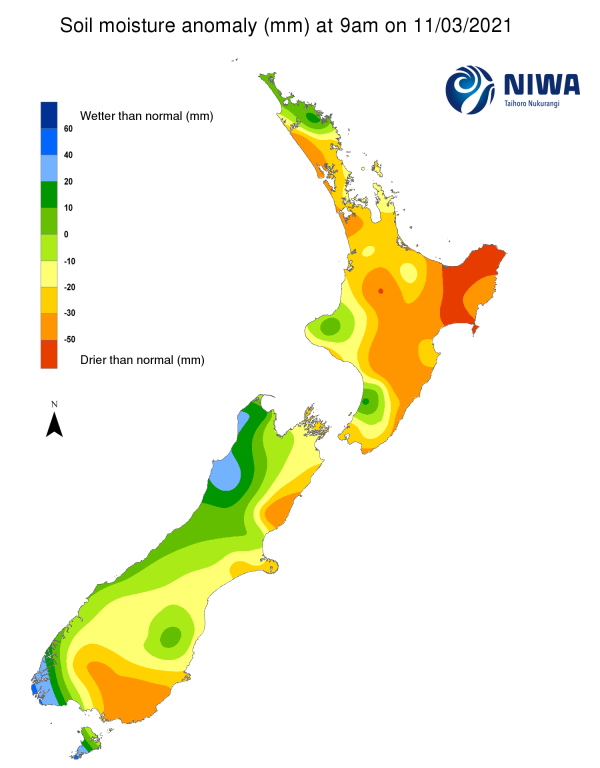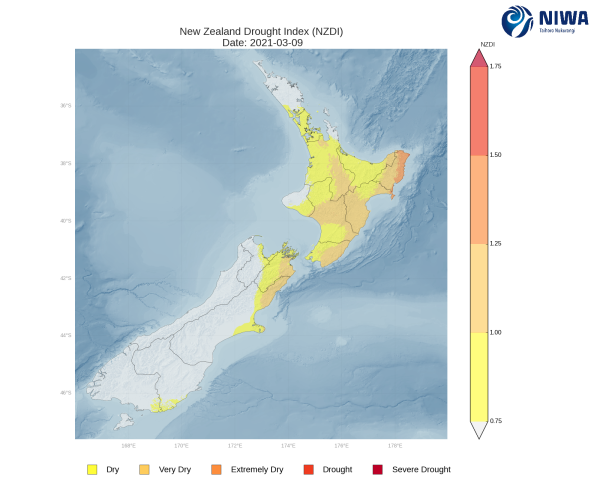A weekly update describing soil moisture patterns across the country to show where dry to extremely dry conditions are occurring or imminent. Regions experiencing significant soil moisture deficits are deemed “hotspots”. Persistent hotspot regions have the potential to develop into drought.
Facts: soil moisture
In the North Island, moderate to heavy rainfall amounts of 30-75 mm were observed in western areas and parts of the coastal fringe East Cape and Hawke’s Bay, with moderate rainfall amounts of 10-30 mm for central areas. However, it was substantially drier in the northern and far southern parts of the North Island, where rainfall was generally below 10 mm for parts of Northland, parts of Auckland and much of Wellington. This resulted in soil moisture increases in parts of western areas of the North Island, slight soil moisture increases for some central regions, and soil moisture decreases for parts of Northland, Auckland and Wellington, while other areas saw little change. The driest soils across the North Island when compared to normal for this time of year, are found from East Cape to Hawke’s Bay, while the wettest soils for this time of the year for the North Island are found in the Far North.
Hotspot conditions have eased somewhat in the last week but are still scattered across western parts of Northland, parts of Auckland, small parts of Waikato, parts of Gisborne, eastern Hawke’s Bay, parts of Manawatū-Whanganui and parts of Wellington. The New Zealand Drought Index (NZDI) map below shows that meteorological drought is in place in a very small portion of East Cape, while widespread dry-to-extremely dry conditions are in place across nearly all of the North Island, excluding parts of Northland, Coromandel and Taranaki.
In the South Island, moderate to heavy rainfall was observed across western areas in the last week, with large parts of the West Coast receiving in excess of 100 mm, along with 30-100 mm falling in parts of the ranges in the Tasman, Canterbury and southern Marlborough. Meanwhile, light to moderate rainfall amounts of less than 30 mm was observed across the east and south, although some areas of Canterbury, Marlborough and Nelson received no rain at all in the last week. This resulted in soil moisture increases for some areas of the northwest and central South Island, with slight soil moisture increases for some parts of the east, while other areas experienced little change. The driest soils in the South Island compared to normal for this time of year are located in eastern Hurunui, eastern Southland and Clutha, while the wettest soils for this time of year are found in Fiordland and parts of Buller.
Hotspots have eased slightly in parts of the Canterbury in the last week but are still currently in place in eastern Hurunui District, Banks Peninsula, east Selwyn and northeast Ashburton Districts, with scattered hotspots in eastern Southland and Clutha District. The New Zealand Drought Index (NZDI) map below shows that dry to very dry conditions are widespread in the northeastern South Island, with small areas of dry conditions in parts of the south.
Outlook and soil moisture
Scattered showers will affect some areas of the central North Island this weekend, ahead of a band of rain bringing wet weather to many western and central areas on Tuesday (16 March). However, high pressure will then bring a return to drier conditions by mid next week. Weekly rainfall totals across the North Island could be quite variable, with some western areas receiving 10-30 mm, but northern and eastern areas may receive 10 mm or less.
Due to the expected weekly rainfall, some slight soil moisture increases will be possible in the western North Island. However, further soil moisture decrease will be likely along the east and the upper North Island. Current hotspots in the northern and eastern North Island may further strengthen and expand.
On Monday (15 March), a band of heavy rain will move up the west of the South Island, with 24 hour rainfall totals over 100 mm possible, particularly in the West Coast. A few scattered showers will then affect western, southern and eastern areas of the South Island on Tuesday. Thereafter, high pressure will build and bring mostly dry conditions for the rest of the week. Weekly rainfall totals are likely to exceed 100 mm in parts of West Coast and western Southland, while the Canterbury ranges could see 20-50 mm. Eastern areas of the South Island may only receive 15 mm or less.
Due to the expected weekly rainfall, further soil moisture increases will be possible in the western South Island. However, at least small additional soil moisture decreases are likely along the east. Current hotspots located in Canterbury, Otago and Southland may slightly strengthen and expand during the next week.
Background:
Hotspot Watch: a weekly advisory service for New Zealand media. It provides soil moisture and precipitation measurements around the country to help assess whether extremely dry conditions are imminent.
Soil moisture deficit: the amount of water needed to bring the soil moisture content back to field capacity, which is the maximum amount of water the soil can hold.
Soil moisture anomaly: the difference between the historical normal soil moisture deficit (or surplus) for a given time of year and actual soil moisture deficits.
Definitions: “Extremely” and “severely” dry soils are based on a combination of the current soil moisture status and the difference from normal soil moisture (see soil moisture maps).
Hotspot: A hotspot is declared if soils are "severely drier than normal" which occurs when Soil Moisture Deficit (SMD) is less than -110 mm AND the Soil Moisture Anomaly is less than -20 mm.
Soil Moisture Anomaly Maps, relative to this time of year. The maps show soil moisture anomaly for the past two weeks.
As of 12 March, the New Zealand Drought Index (NZDI) map below shows that meteorological drought is in place in a very small portion of East Cape. Widespread dry-to-extremely dry conditions are in place across nearly all of the North Island, excluding parts of Northland, Coromandel and Taranaki, as well as the northeastern South Island, with dry conditions in a small portion of the southern South Island. Please note: some hotspots in the text above may not correspond with the NZDI map. This difference exists because the NZDI uses additional dryness indices, including one which integrates the rainfall deficit over the past 60 days. Changes are therefore slower to appear in the NZDI compared to soil moisture anomaly maps that are instantaneously updated.





